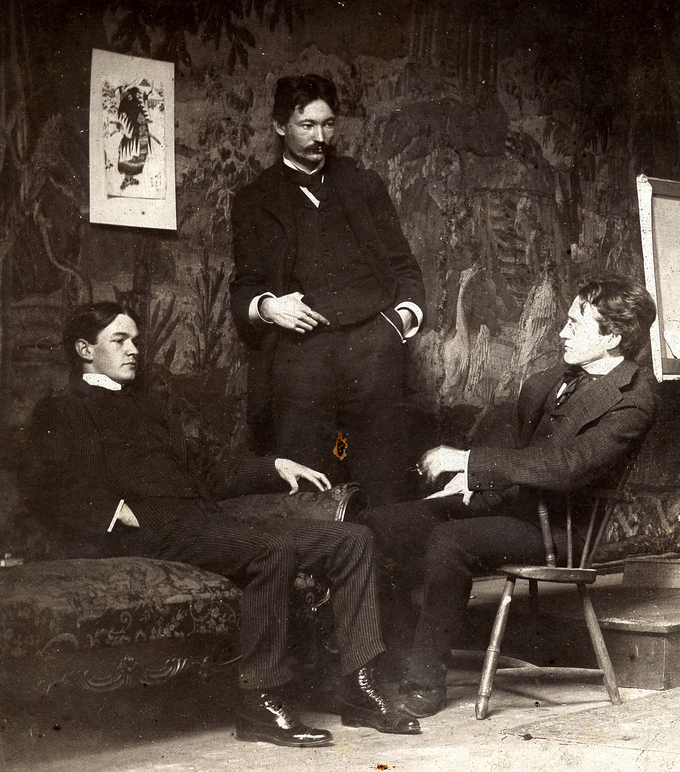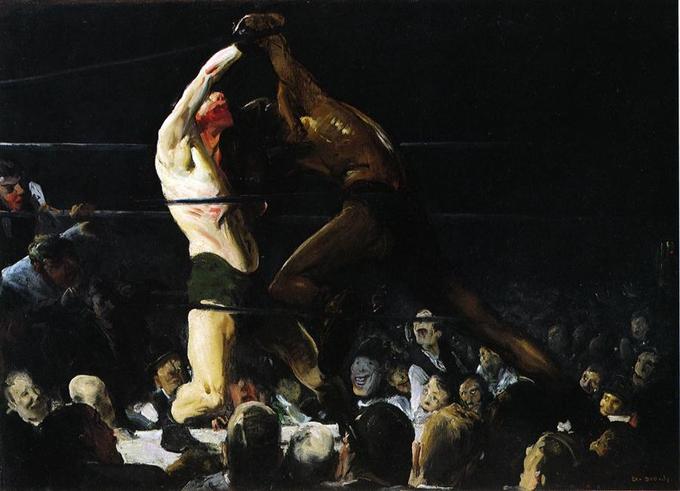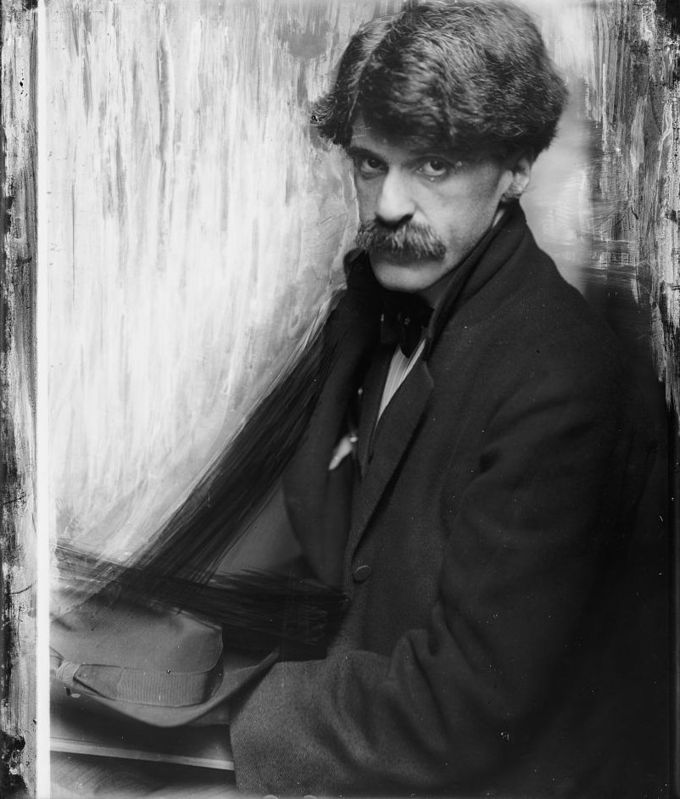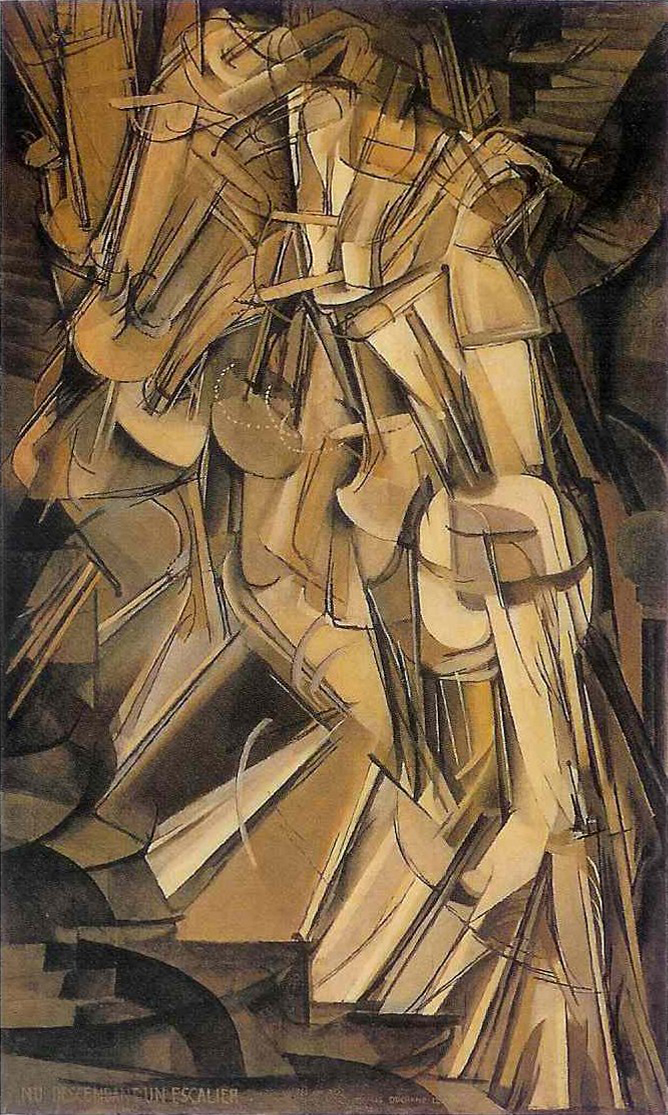29.3: Modernism in America
- Page ID
- 53132
American Painting: The Ashcan School
The Ashcan School was a movement within American Realism known for portraying scenes of daily life in New York’s poorer neighborhoods.
Learning Objectives
Describe the origins and focus of the Ashcan School
Key Takeaways
Key Points
- American Realism arose in the late 19th and early 20th centuries with works of art that depicted contemporary views of daily life, and the Ashcan School was central to that movement.
- The artists of the Ashcan School rebelled against American Impressionism, contrasting the Impressionists’ emphasis on light with Realist works that were darker in tone and captured harsher moments in life.
- Ashcan School artists portrayed prostitutes, drunks, butchered pigs, overflowing tenements, and boxing matches. Their focus on poverty and the daily realities of urban life prompted critics to consider them on the fringe of Modern art.
Key Terms
- American Realism: An early 20th century idea in art, music, and literature that reflected contemporary issues and events.
- American Impressionism: American Impressionism was a style of painting related to European Impressionism and practiced by American artists in the United States during the late 19th and early 20th centuries. American Impressionism is a style of painting characterized by loose brushwork and vivid colors.
Overview
The Ashcan School was a movement within American Realism that came into prominence in New York City during the early 20th century and is best known for works portraying scenes of daily life in New York’s poorer neighborhoods.
American Realism
American Realism was a concept that arose in the late 19th and early 20th centuries in art, music, and literature. Whether it was a portrayal of contemporary culture, or a scenic view of downtown New York City, Realist works depicted a contemporary view of what was happening or what was “real.”
In America at the beginning of the 20th century, a new generation of painters, writers, and journalists were coming of age who were interested in creating a new style that reflected city life and an American population that was becoming increasingly more urban as the country entered the new century. American Realism attempted to portray the exhaustion and cultural exuberance of the American landscape and the life of ordinary people at home. Artists used the rapidly growing setting of the city to influence the color, texture, and look of their creative projects.
Pulling away from fantasy and focusing on the grit and reality of daily life, American Realism presented a breakthrough—introducing Modernism, and what it means to be in the present. The Ashcan School, also known as “The Eight,” was central to the new American Modernism in the visual arts.
The Ashcan School
The Ashcan School was a group of New York City artists who sought to capture the feel of turn-of-the-century New York through realistic portraits of everyday life. The movement grew out of a group known as The Eight, many of whom had experience as newspaper illustrators, and whose only show together in 1908 created a sensation. These artists were not only depicting Fifth Avenue socialites, but also the lower class and richly textured immigrant cultures. Critics of the time did not always appreciate their choice of subjects, which included alleys, tenements, slum dwellers, and in the case of John French Sloan, taverns frequented by the working class.
Five artists of The Eight, William Glackens, Robert Henri, George Luks, Everett Shinn, and John French Sloan became associated with the Ashcan School. However, the Ashcan School was not an organized group. Instead their unity consisted of a desire to tell truths about the state of the city. The first known use of the “ashcan” terminology in describing the movement was by Art Young in 1916.

Shinn Henri Sloan: Everett Shinn, Robert Henri, and John Sloan, c. 1896 (unidentified photographer, black and white print, 18 x 13 cm.)
The artists of the Ashcan School rebelled against American Impressionism, which was the vanguard of American art at the time. In contrast to the Impressionists’ emphasis on light, their Realist works were generally darker in tone, capturing harsher moments of life and often portraying such subjects as prostitutes, drunks, butchered pigs, overflowing tenements, boxing matches, and wrestlers. It was their frequent, although not total, focus upon poverty and the daily realities of urban life that prompted American critics to consider them to be on the fringe of Modern art.

Photography in America
Photography developed as an art form throughout the early 20th century largely due to a number of artists who worked to legitimize the medium by moving it into a gallery setting.
Learning Objectives
Describe the establishment of photography as an art form in the early 20th century
Key Takeaways
Key Points
- In the early 1900s, the Daguerreotype emerged as the most popular and affordable photographic method for the general public.
- In 1884 George Eastman, of Rochester, New York, developed dry gel on paper, or film, to replace the photographic plate so that a photographer no longer needed to carry boxes of plates and toxic chemicals around, further popularizing the medium.
- Alfred Stieglitz and Edward Steichen were instrumental in making photography a fine art, and Stieglitz was especially notable in introducing it into museum collections.
- In addition to his fame as a photographer, Stieglitz is known as a writer, publisher, exhibition organizer, and collector. As an owner of multiple New York art galleries, he introduced many photographers and other artists, including new European avante-garde artists, to the U.S. art world.
- Stieglitz was involved in a number of photographic organizations and journals in New York city throughout his career. He used these platforms to promote photography as a fine art, and contributed to its acceptance in the art world.
- The Photo-Secession movement placed the focus on the role of the photographer as an artist and was characterized by pictorialism, in which pictures and photographic materials were manipulated to emulate the quality of paintings and etchings being produced at that time.
Key Terms
- abstract: Free from representational qualities. Abstract art uses a visual language of form, color, and line to create a composition that exists with a degree of independence from visual references in the world.
History of Photography
The history of photography has roots in antiquity with the discovery of the principle of the camera obscura, and the observation that some substances are visibly altered by exposure to light. Thomas Wedgwood is generally accepted to have made the first reliably documented although unsuccessful attempt. In the mid-1820s, Nicéphore Niépce succeeded, but several days of exposure in the camera were required and the earliest results were very crude. Niépce’s associate Louis Daguerre went on to develop the Daguerreotype process, the first publicly announced photographic process, which required only minutes of exposure in the camera and produced clear, finely detailed results. It was commercially introduced in 1839, a date generally accepted as the birth year of practical photography.
Throughout the late 1800s and early 1900s a number of competing processes were experimented with and distributed to the public in varying degrees. The demand for portraiture that emerged from the middle classes during the Industrial Revolution could not be met in volume and in cost by oil painting, a factor that added to the push for the development of photography. Eventually, the Daguerreotype emerged as the most popular and affordable method for the general public, however, Daguerreotypes were fragile and difficult to copy, and lacked portability as they required plates and toxic chemicals to be carried around.
In 1884 George Eastman, of Rochester, New York, developed dry gel on paper, or film, to replace the photographic plate so that a photographer no longer needed to carry boxes of plates and toxic chemicals around. In July 1888 Eastman’s Kodak camera went on the market with the slogan “You press the button, we do the rest.” Now anyone could take a photograph and leave the complex parts of the process to others, and photography became available for the mass-market in 1901 with the introduction of the Kodak Brownie.
Photography as Art
Successful attempts to make fine art photography can be traced to Victorian era practitioners such as Julia Margaret Cameron, Charles Lutwidge Dodgson, Oscar Gustave Rejlander, and others. In the U.S., F. Holland Day, Ansel Adams, Alfred Stieglitz, and Edward Steichen were instrumental in making photography a fine art, and Stieglitz was especially notable in introducing it into museum collections. Until the late 1970s several genres predominated, such as nudes, portraits, and natural landscapes. Breakthrough artists in the 1970s and 80s, such as Sally Mann, Robert Mapplethorpe, Robert Farber, and Cindy Sherman, still relied heavily on such genres, although saw them with fresh eyes. Others investigated a snapshot aesthetic approach. American organizations, such as the Aperture Foundation and the Museum of Modern Art, have done much to keep photography at the forefront of the fine arts.
Photo-Secession Movement
Photographer Alfred Steiglitz (1864–1946) led the Photo-Secession movement, a movement that promoted photography as a fine art and sought to raise standards and awareness of art photography. The Photo-Secession movement placed the focus on the role of the photographer as an artist. It was characterized by pictorialism, in which pictures and photographic materials were manipulated to emulate the quality of paintings and etchings being produced at that time. Among the methods used were soft focus; special filters and lens coatings; burning, dodging and/or cropping in the darkroom to edit the content of the image; and alternative printing processes such as sepia toning, carbon printing, platinum printing or gum bichromate processing.

Gertrude Käsebier, Portrait of Alfred Stieglitz: A picture of Alfred Stieglitz by Gertrude Käsebier, 1902.
Centered in Gallery 291 in New York City from 1902–1916, membership to the Photo-Secession movement was by invitation-only and varied according to Stieglitz’s interests. The most prominent members included Edward Steichen, Clarence H. White, Gertrude Käsebier, Frank Eugene, F. Holland Day, and Alvin Langdon Coburn.

Alfred Stieglitz, Georgia O’Keeffe, Hands: Alfred Stieglitz, Georgia O’Keeffe, Hands, 1918.
At the same time, however, photography’s use as a tool of realistic documentation mirrored the growth of American Realism in art and sculpture. Many photographers sought to capture everyday life of American people—both the wealthy and the poor—in a realistic and often gritty fashion. Lewis Hine (1874–1940) used light to illuminate the dark areas of social existence in his Pittsburgh Survey (1907), which investigated working and living conditions in Pittsburgh. He later became the photographer for the National Child Labor Committee. Paul Strand (1890–1976) created brutally direct abstractions, close-up portraits, and documented machines and cityscapes.
Precisionist Movement
Edward Weston (1886–1958) would become a leader in the Precisionist Movement, a style that functioned in direct opposition to the Photo-Secession Movement. This movement was the first true use of modernism in photography. It was characterized by sharp focus and carefully framed images. James Van Der Zee (1886–1983) was an African American photographer who became emblematic of the Harlem Renaissance movement. He was best known for his portraits of black New Yorkers and produced the most comprehensive documentation of the period.
Commercial Photography
Commercial photography also expanded during this time, as in the works of Edward Steichen (1879–1973). Steichen broke with Stieglitz toward the end of the Photo-Secession movement and created the first commercial image in 1919, entitled Pear and Apple. His work was featured in magazines such as Vanity Fair. Ansel Adams (1902–1984) also began his career as a commercial photographer and became widely known for his images of American landscapes.

Ansel Adams, The Tetons and the Snake River, 1942: A typical Ansel Adams photograph featuring the American landscape in black and white.
The Armory Show
The Armory Show of 1913 displayed the work of European avant-garde artists alongside their American counterparts.
Learning Objectives
Discuss the influence of the Armory Show in introducing the artistic styles of Impressionism, Fauvism, and Cubism to the American public
Key Takeaways
Key Points
- The Armory Show of 1913 displayed about 1,300 works by over 300 artists with the goal of bringing the best avant-garde European art to an American audience.
- Contemporary responses to the European Impressionist, Fauvist, and Cubist works were filled with accusations of quackery, insanity, immorality, and anarchy.
- The Armory Show introduced New Yorkers accustomed to the naturalistic art of American Realism to the styles of European avant-garde artists and served as a catalyst for American artists to create their own artistic language.
- The Armory Show has since evolved into an annual contemporary art fair.
Key Terms
- Fauvism: An artistic movement of the last part of the 19th century that emphasized spontaneity and the use of extremely bright colors.
- Cubism: An early 20th century avant-garde art movement pioneered by Pablo Picasso and Georges Braque, where objects are analyzed, broken up, and reassembled in an abstracted form.
- American Realism: An early 20th century idea in art, music, and literature that reflected contemporary issues and events.
The Armory Show was the first exhibition organized by the Association of American Painters and Sculptors. The exhibition ran in New York City’s 69th Regiment Armory from February 17 until March 15, 1913 and displayed about 1,300 paintings, sculptures, and decorative works by over 300 artists. The initial premise of the show was to exhibit the best avant-garde European art alongside the best works of American artists to audiences in New York City, Chicago, and Boston.

Armory Show Poster, 1913: A poster displaying the name of the show, the time and place of the show, and the featured artists.
Impressionism, Fauvism, and Cubism were among the European avant-garde schools represented. News reports and reviews of the show were filled with accusations of quackery, insanity, immorality and anarchy, often including parodies, caricatures, and mock exhibitions. Criticism aside, civil authorities did not interfere with the show. Among the scandalously radical works of art were Marcel Duchamp’s Cubist/Futurist style Nude Descending a Staircase (1912), in which he expressed motion with successive superimposed images.

Nude Descending a Staircase, No. 2 by Marcel Duchamp: Marcel Duchamp, Nude Descending a Staircase, No. 2, 1912, oil on canvas, 58 x 35 in. Philadelphia Museum of Art.
Art critic Julian Street wrote that the work resembled “an explosion in a shingle factory” while cartoonists satirized the piece. Gutzon Borglum, one of the early organizers of the show, labeled this piece “A staircase descending a nude,” while J. F. Griswold, a writer for the New York Evening Sun, entitled it “The rude descending a staircase (Rush hour in the subway).” Despite these negative reactions, the purchase of Paul Cézanne’s Hill of the Poor (View of the Domaine Saint-Joseph) by the Metropolitan Museum of Art signaled an integration of Modernism into the established New York museums. Duchamp’s brother, going by the “nom de guerre” Jacques Villon, also exhibited at the Armory Show, striking a sympathetic chord with New York collectors.The exhibition went on to the Art Institute of Chicago and then to The Copley Society of Art in Boston.

Caricature of Cubism at the Armory Show: “A Slight Attack of Third Dimentia Brought on by Excessive Study of the Much Talked of Cubist Pictures in the International Exhibition at New York,” drawn by John French Sloan in April 1913. Published before 1923.
The Armory Show introduced New Yorkers accustomed to the naturalistic art of American Realism to the styles of the European avant-gardes. The show also served as a catalyst for American artists, who subsequently began to experiment more and became more independent in creating their own artistic language. There have been many exhibitions throughout the 20th century that celebrated the show’s legacy. The “New” New York Armory Show was held in piers on the Hudson River in 1994 and has since evolved into an annual contemporary art fair.
- Curation and Revision. Provided by: Boundless.com. License: CC BY-SA: Attribution-ShareAlike
- American realism. Provided by: Wikipedia. Located at: en.Wikipedia.org/wiki/American_realism. License: CC BY-SA: Attribution-ShareAlike
- Ashcan School. Provided by: Wikipedia. Located at: en.Wikipedia.org/wiki/Ashcan_School. License: CC BY-SA: Attribution-ShareAlike
- American Realism. Provided by: Wikipedia. Located at: en.Wikipedia.org/wiki/American%20Realism. License: CC BY-SA: Attribution-ShareAlike
- American Impressionism. Provided by: Wikipedia. Located at: en.Wikipedia.org/wiki/American%20Impressionism. License: CC BY-SA: Attribution-ShareAlike
- Shinn Henri Sloan. Provided by: Wikipedia. Located at: en.Wikipedia.org/wiki/File:Shinn_Henri_Sloan.jpg. License: CC BY-SA: Attribution-ShareAlike
- Both Members of This Club George Bellows. Provided by: Wikipedia. Located at: en.Wikipedia.org/wiki/File:Both_Members_of_This_Club_George_Bellows.jpeg. License: CC BY-SA: Attribution-ShareAlike
- Alfred Stieglitz. Provided by: Wikipedia. Located at: en.Wikipedia.org/wiki/Alfred_Stieglitz. License: CC BY-SA: Attribution-ShareAlike
- abstract. Provided by: Wikipedia. Located at: en.Wikipedia.org/wiki/abstract. License: CC BY-SA: Attribution-ShareAlike
- Shinn Henri Sloan. Provided by: Wikipedia. Located at: en.Wikipedia.org/wiki/File:Shinn_Henri_Sloan.jpg. License: CC BY-SA: Attribution-ShareAlike
- Both Members of This Club George Bellows. Provided by: Wikipedia. Located at: en.Wikipedia.org/wiki/File:Both_Members_of_This_Club_George_Bellows.jpeg. License: CC BY-SA: Attribution-ShareAlike
- Adams_The_Tetons_and_the_Snake_River.jpg. Provided by: Wikipedia. Located at: upload.wikimedia.org/Wikipedia/commons/2/21/Adams_The_Tetons_and_the_Snake_River.jpg. License: CC BY-SA: Attribution-ShareAlike
- O'Keeffe-(hands). Provided by: Wikipedia. Located at: en.Wikipedia.org/wiki/File:O'Keeffe-(hands).jpg. License: Public Domain: No Known Copyright
- Alfred Stieglitz. Provided by: Wikipedia. Located at: en.Wikipedia.org/wiki/File:Alfred_Stieglitz.jpg. License: Public Domain: No Known Copyright
- The Armory Show. Provided by: Wikipedia. Located at: en.Wikipedia.org/wiki/The_Armory_Show. License: CC BY-SA: Attribution-ShareAlike
- American Realism. Provided by: Wikipedia. Located at: en.Wikipedia.org/wiki/American%20Realism. License: CC BY-SA: Attribution-ShareAlike
- Fauvism. Provided by: Wiktionary. Located at: en.wiktionary.org/wiki/Fauvism. License: CC BY-SA: Attribution-ShareAlike
- Cubism. Provided by: Wikipedia. Located at: en.Wikipedia.org/wiki/Cubism. License: CC BY-SA: Attribution-ShareAlike
- Shinn Henri Sloan. Provided by: Wikipedia. Located at: en.Wikipedia.org/wiki/File:Shinn_Henri_Sloan.jpg. License: CC BY-SA: Attribution-ShareAlike
- Both Members of This Club George Bellows. Provided by: Wikipedia. Located at: en.Wikipedia.org/wiki/File:Both_Members_of_This_Club_George_Bellows.jpeg. License: CC BY-SA: Attribution-ShareAlike
- Adams_The_Tetons_and_the_Snake_River.jpg. Provided by: Wikipedia. Located at: upload.wikimedia.org/Wikipedia/commons/2/21/Adams_The_Tetons_and_the_Snake_River.jpg. License: CC BY-SA: Attribution-ShareAlike
- O'Keeffe-(hands). Provided by: Wikipedia. Located at: en.Wikipedia.org/wiki/File:O'Keeffe-(hands).jpg. License: Public Domain: No Known Copyright
- Alfred Stieglitz. Provided by: Wikipedia. Located at: en.Wikipedia.org/wiki/File:Alfred_Stieglitz.jpg. License: Public Domain: No Known Copyright
- Duchamp - Nude Descending a Staircase. Provided by: Wikipedia. Located at: en.Wikipedia.org/wiki/File:Duchamp_-_Nude_Descending_a_Staircase.jpg. License: Public Domain: No Known Copyright
- ArmoryShow poster. Provided by: Wikipedia. Located at: en.Wikipedia.org/wiki/File:ArmoryShow_poster.jpg. License: Public Domain: No Known Copyright
- Sloan cubism. Provided by: Wikipedia. Located at: en.Wikipedia.org/wiki/File:Sloan_cubism.jpg. License: Public Domain: No Known Copyright

